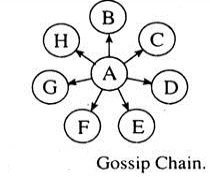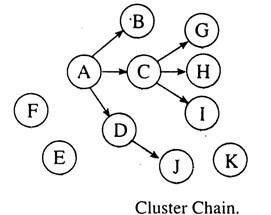Grapevine is a form of informal communication, operates both in internal and external informal channels which can contribute to and benefit the organization.
Therefore, it is found in all organizations. It does not follow any prescribed or predetermined rule and spreads any information quickly.
Through the grapevine, information flows in different directions linking almost every one of an organization.
It is governed by social and personal relationships rather than officially recognized rules and formalities.
Grapevine operates both in internal and external informal channels. It passes opinions, suspicions, and rumors that generally do not move through formal channels.
By nature, the grapevine is a channel of horizontal communication.
The term ‘Grapevine Communication’ originated during the American Civil War (1861- 1865). During the period the communication of intelligence information through telegraph was not effective and reliable because the telegraph system was unorganized. Telegraph lines were strung in a haphazard way through the trees like a real grapevine.
The messages received or sent through these lines were often incorrect and confusing. Rumors were rampant during the civil war. Thus any rumor, whatever might be the source, was presumed to be originated from the unarranged telegraph lines or grapevine. Later, in course of time, grapevine communication has become synonymous with informal communication.
Examples of Informal or Grapevine Communication:
- The manager calls an employee to his chamber and talks with him for sometimes relating to official work. Rumor is spread that the employee will be promoted to higher position ignoring the promotion of other employees.
- The employees of a company have come to know the profit figure for the year from the accounts department. Somebody among the employees within the company puts some imagination to it and tells others that the company is going to offer bonus to the employees on the basis of profit earned.
Patterns or Types of Grapevine
The grapevine communication is usually horizontal in nature. But it can be horizontal, vertical and diagonal. Prof. Keith Davis has classified grapevine into 4 types.
- Single Strand Chain
- Gossip Chain
- Probability Chain
- Cluster Chain
- Single Strand Chain
In this type of grapevine communication the information passes through a number of persons like a chain. A tells something to B, who tells it to C, who tells it to D and so on.

It is generally a long chain. The longer the chain the greater is the possibility of distortion of the information.
- Gossip Chain
In Gossip Chain one person actively conveys information to other persons around him. A circle or wheel-like figure is formed in this communication.
Here, in this picture. A is at the centre and transmits messages to ‘B’, ‘C\ ‘D\ ‘E\ ‘F, ‘G’, and ‘H’ around him/her.

Gossip Chain is generally used when information to be communicated is non-job oriented in nature.
- Probability Chain
It is a random process in which information may move from one person to any other person or persons according to law of probability. Naturally, in this type of communication, some people of the organization will be informed and some others will remain outside the arena of the communication.
Here, in the illustration, E, F, G and K are outside the communication chain. This chain is used when information is interesting but less important.

- Cluster Chain
Cluster chain is mostly used and the dominant pattern of grapevine communication. In this type one person tells something to some selected trust worthy persons. Some of these persons may inform a few selected other individuals. Here in the picture, A tells some selected and trustworthy persons, B, C and D. C again relays it to his selected persons, G, H and I. D tells J, a person of his choice. E and F remain outside the cluster.

Importance of Informal or Grapevine Communication
Informal or Grapevine communication is an indispensable part of entire communication system. Formal communication is compared to arteries of a living being, whereas, grapevine or informal communication are like veins. The later is a supplement to the former. Where formal communication fails to operate, grapevine or informal communication is used.
Sometimes, grapevine communication is more effective than the formal communication. In fact, it carries more information than formal communication. Not only is a large volume of information, important and vital information also conveyed through it.
In an organization small groups of people work together. It is quite natural that they will become interested about each other and want to know various information regarding each other’s service condition, salary, facilities available, appointment, retirement, transfer, punishment, etc.
They will also be interested to know any private, secret and confidential information which includes any romantic affair, family disputes, marriage, birth of a child, examination results of their children, special treatment or favour by boss to any member and so on.
The employees generally exchange their views with their peers openly during lunch break or at an interval and get emotional relief from monotony and stress. Thus, the informal or grapevine communication promotes social relationship among the participants. It helps to build up unity, integrity and solidarity among them and boosts up their morale.
Grapevine or informal communication is faster than the formal communication. Being oral in nature, it has little or no cost and can reach maximum number of people irrespective of their positions within a very short time.
Since there is no official procedure and formalities it is not binding and compelling, rather it is flexible and spontaneous. The managers can get feedback from their subordinates quickly on the plan and policies through grapevine. New ideas, suggestions, opinions may come out as people can express their feelings without fear.
Characteristics of Informal Communication
The informal communication has the following characteristics:
(i) It is based on informal relationship.
(ii) It grows spontaneously.
(iii) It takes the form of gossip.
(iv) It is conveyed through conversation, facial expression, body movement, silence, etc.
(v) It does not follow any structured route or channel.
(vi) Small groups are formed with like-minded people in such communication.
(vii) It is direct and fast.
(viii) It is flexible and dynamic in nature.
Advantages of Informal or Grapevine Communication
The advantages of informal communication are pointed out below:
(i) Informal communication, being unofficial and personal, promotes a social relationship among the participants.
(ii) Flow of information is fast and is suitable for emergencies.
(iii) New ideas, suggestions, opinions may come out through such communication as people can express their feelings without fear.
(iv) It can create an atmosphere congenial for work as the relationship between the managers and the employees improves.
(v) The managers can collect information regarding reaction of the workers, attitude of the employees of other departments, intention of peer officers through such communication. It is not possible in the case of formal communication. Thus, informal communication supplements the formal communication to fulfill the objective of the organization.
(vi) Sharing of information in a free atmosphere makes the picture clear, bringing out the hidden dimension of the management, if any. It puts an end to misunderstanding and suspicion.
(vii) It is an outlet of expression of complaints, dis-likings, grievances, etc.
Disadvantages/Limitations of Informal or Grapevine Communication
Informal Communication has the following disadvantages or limitations:
(i) Inaccurate, incomplete and half true information’s are spread through informal communication as everybody interprets it in his/her own way.
(ii) In most cases it is emotional and full of sentiments which can change its meaning.
(iii) No one can be held responsible as it is not possible to find out the supplier of wrong information in the case on an enquiry.
(iv) It is not reliable. The managers cannot depend upon such information as it does not follow any norm and is too loose a system. No decision can be taken depending upon such communication.
(v) It spreads rumors and endangers consolidation and unity of the organization.
(vi) It creates conflicts between groups by spreading rumors against them and reducing their mental strength.
5 Ways to make Grapevine Beneficiary to Organization
- Providing real news to the grapevine initiators
Managers should identify the people who take an active part in grapevine channels and provide them with real news so that they can transmit real facts to the grapevine channels.
This will eventually, resist transmission of rumor, untrue and distorted messages.
- Considering grapevine as a pulse feeling tool
Since grapevine is an important source of receiving feedback, managers should use it as a tool for feeling the pulse of the employees.
- Contradicting the false rumor
If any false rumor occurs in the organization, management should immediately contradict and protest the rumor through formal channels.
As a result, the feeding of false rumors will decrease.
- Allowing workers in the decision-making process
If the workers are allowed to take part in the decision-making process, they will be well informed of the facts.
In such a situation, there will be nothing to suspect and to create a false rumor.
- Developing good organizational climate
Good organizational climate impels the employees to develop a sense of belongingness, to maintain status, chain of command and self-respect, and to enhance satisfaction.
All these will facilitate the occurrence of grapevine in the most desired and effective way.
At last, we can say that though the organization cannot hire and fire the grapevine, it can ensure an environment where people can practice grapevine in the most desired and effective way.
One thought on “Grapevine Communication”